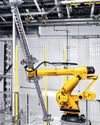
May 2019 marked the 500th anniversary of the death of Leonardo Da Vinci. The UK’s Royal Collection has the most important group of Leonardo’s drawings to survive. It’s more than 500 sheets that have been together as a group since the artist’s death.
Can you contextualise for us the importance of these drawings?
Martin Clayton Drawing was central to Leonardo’s work. It’s the paintings that have survived today, but he was also a sculptor, an architect, an engineer and a scientist. But none of his sculptures survived, and we can’t tell if any of his architecture was even executed. His engineering seems mostly to have been designed, rather than built, and none of his science reached a conclusion that he was ready to publish. But through the drawings, we get to know all these different fields of activity. We see in his drawings not just the preparations for his paintings, but also the preliminary works for his sculpture and architecture, so we can understand what he was working towards.
How did science influence his art?
This story is from the May/June 2020 edition of Very Interesting.
Start your 7-day Magzter GOLD free trial to access thousands of curated premium stories, and 8,500+ magazines and newspapers.
Already a subscriber ? Sign In
This story is from the May/June 2020 edition of Very Interesting.
Start your 7-day Magzter GOLD free trial to access thousands of curated premium stories, and 8,500+ magazines and newspapers.
Already a subscriber? Sign In

HOW TO MASTER YOUR METABOLISM
Ready to welcome a leaner, healthier you? It's time for a metabolic makeover. With a few simple, research-backed changes, you can supercharge your body's calorie-burning

A BLUEPRINT FOR ANTI AGEING
Science says it's time to rethink - and take control - of our body's age. Here's how to slow, halt and potentially turn back your biological clock

THE BROKEN MIRROR
Body dysmorphia - the all-consuming obsession with perceived flaws in our looks - is sweeping the globe. One in five young people is thought to be affected. What can be done and how is tech changing the way we see ourselves?

SCROLL REVERSAL
Losing days by endlessly scrolling on your smartphone? You're not alone. Perhaps neuroscience can help us beat the urge

Going back to the moon
ARTEMIS AND A NEW DAWN OF LUNAR EXPLORATION

SAD CLOWN PARADOX: WHY TEARS OFTEN LIE BEHIND THE LAUGHS
Mental health issues are common among comedians and performing is just one way they can self-medicate

INDOOR AIR POLLUTION: HOW COOKING CAN DAMAGE YOUR DNA
From roast dinners to scented candles, there are potentially harmful pollutants lurking in every home

FARM OF THE FUTURE
Join the BBC's Planet Earth III film crew and go behind the scenes in the city farm that's transforming fields into towers and running almost everything with robots

COULD ONE BOMB DESTROY THE WORLD?
How big a bang are arms manufacturers capable of creating?

THE THREAT OF DAY ZERO
Queues at public water taps could become normal. What can we do to avoid them?